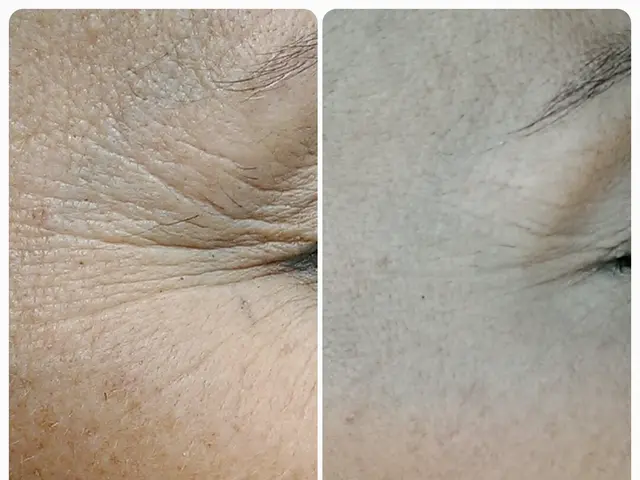Lobular Carcinoma In Situ (LCIS): Characteristics, Malignancy, and Additional Information
Lobular carcinoma in situ (LCIS) is a non-cancerous condition that affects the lobules, the milk-producing glands, within the breast. It is less common than other types of breast abnormalities, accounting for fewer than 2% of all breast cancers [1]. In this article, we delve into the aspects of LCIS, its prevalence, severity, treatment options, and risk factors.
Prevalence and Risk
LCIS is found in 0.5 to 1.5% of non-cancerous breast biopsies and in 1.8 to 2.5% of all breast biopsies [2]. In contrast, ductal carcinoma in situ (DCIS) is the most common non-invasive breast cancer, accounting for about 90% of all in situ breast carcinomas [1].
Unlike DCIS, LCIS itself is considered a marker of increased risk for both invasive lobular and ductal breast cancer rather than a true cancer. Studies show that about 5.7%-9.9% of women with LCIS develop invasive breast cancer within 7-10 years [3]. Although LCIS does not always progress to invasive cancer, it indicates a higher risk.
Pathology and Treatment
LCIS involves lobular cells and lobules, with atypical lobular hyperplasia often coexisting. LCIS is genetically related to invasive lobular tumors but has less clonal overlap with invasive ductal cancers [1].
Treatment for LCIS depends on whether it is found in a needle or an excision biopsy. In some cases, LCIS may require further treatment, especially if it looks pleomorphic or has necrosis. However, LCIS is often managed with observation and risk-reduction strategies rather than immediate surgery or radiation, as it is not cancer but an indicator of risk [4]. Sometimes, endocrine therapy is used to lower the risk. Surgery may not be required unless there is suspicion or evidence of invasive cancer [4].
In contrast, DCIS is treated more aggressively with surgery (lumpectomy or mastectomy), often combined with radiation therapy to prevent progression, and occasionally endocrine therapy if hormone receptor positive. The aim of DCIS treatment is to prevent invasive cancer development [1].
Risk Factors and Prevention
The exact cause of LCIS is unknown, but risk factors are similar to those of breast cancer. These include family history of breast cancer, smoking, and excess alcohol consumption [2]. Regular exercise, maintaining a healthy weight, and limiting alcohol consumption are recommended lifestyle changes to decrease the risk of breast cancer, and by extension, LCIS [6].
The use of hormone replacement therapy (HRT) for menopause has been linked to an increased risk of LCIS [5]. Doctors may recommend medications such as tamoxifen, raloxifene, or aromatase inhibitors to lower the risk of developing breast cancer, which indirectly helps in reducing the risk of LCIS [7].
Diagnosis and Surveillance
Doctors usually find LCIS during a biopsy for a nearby breast condition. LCIS may not show on a mammogram [2]. In addition to a yearly mammogram, a doctor may recommend a breast exam every six months for people with LCIS [8].
Females with LCIS who develop breast cancer usually get an early-stage diagnosis [5]. Given the increased risk associated with LCIS, regular surveillance and preventive measures are crucial.
In conclusion, LCIS is a marker of increased risk for developing invasive breast cancer rather than a true cancer itself. It is less common than DCIS and is often managed conservatively with surveillance and preventive measures. Regular exercise, maintaining a healthy weight, and limiting alcohol consumption are recommended lifestyle changes to decrease the risk of breast cancer, and by extension, LCIS. Early detection and regular surveillance are key in managing LCIS and reducing the risk of invasive breast cancer.
[1] National Cancer Institute. (2021). Lobular Carcinoma In Situ (LCIS). Retrieved from https://www.cancer.gov/types/breast/lobular-carcinoma-in-situ
[2] American Cancer Society. (2021). What is lobular carcinoma in situ (LCIS)? Retrieved from https://www.cancer.org/cancer/lobular-carcinoma-in-situ-lcis/about/what-is-lobular-carcinoma-in-situ-lcis.html
[3] National Cancer Institute. (2019). Lobular Carcinoma In Situ (LCIS): Statistics. Retrieved from https://www.cancer.gov/types/breast/hp/lobular-carcinoma-in-situ-statistics
[4] American Cancer Society. (2021). Treating lobular carcinoma in situ (LCIS). Retrieved from https://www.cancer.org/cancer/lobular-carcinoma-in-situ-lcis/treatment/treating-lobular-carcinoma-in-situ-lcis.html
[5] American Cancer Society. (2021). Lobular carcinoma in situ (LCIS): Risk factors and prevention. Retrieved from https://www.cancer.org/cancer/lobular-carcinoma-in-situ-lcis/causes-risks-prevention/risk-factors-prevention.html
[6] American Cancer Society. (2021). Reducing your risk of breast cancer. Retrieved from https://www.cancer.org/cancer/breast-cancer/about/reducing-your-risk.html
[7] American Cancer Society. (2021). Medications to reduce breast cancer risk. Retrieved from https://www.cancer.org/cancer/breast-cancer/about/medications-to-reduce-breast-cancer-risk.html
[8] National Cancer Institute. (2021). Follow-up care for women with lobular carcinoma in situ (LCIS). Retrieved from https://www.cancer.gov/types/breast/patient/lobular-carcinoma-in-situ-treatment-pdq/page-3
- LCIS involves lobular cells and lobules, with atypical lobular hyperplasia often coexisting.
- LCIS is genetically related to invasive lobular tumors but has less clonal overlap with invasive ductal cancers.
- LCIS itself is considered a marker of increased risk for both invasive lobular and ductal breast cancer rather than a true cancer.
- Studies show that about 5.7%-9.9% of women with LCIS develop invasive breast cancer within 7-10 years.
- The exact cause of LCIS is unknown, but risk factors are similar to those of breast cancer.
- Family history of breast cancer, smoking, and excess alcohol consumption are risk factors for LCIS.
- Regular exercise, maintaining a healthy weight, and limiting alcohol consumption are recommended to decrease the risk of breast cancer and LCIS.
- The use of hormone replacement therapy (HRT) for menopause has been linked to an increased risk of LCIS.
- Doctors may recommend medications such as tamoxifen, raloxifene, or aromatase inhibitors to lower the risk of developing breast cancer, which indirectly helps in reducing the risk of LCIS.
- LCIS may not show on a mammogram, so doctors may recommend a breast exam every six months for people with LCIS.
- LCIS is less common than DCIS and is often managed conservatively with surveillance and preventive measures.
- Treatment for LCIS depends on whether it is found in a needle or an excision biopsy.
- In some cases, LCIS may require further treatment, especially if it looks pleomorphic or has necrosis.
- Sometimes, endocrine therapy is used to lower the risk of developing invasive breast cancer for those with LCIS.
- Surgery may not be required unless there is suspicion or evidence of invasive cancer for those with LCIS.
- DCIS is treated more aggressively with surgery (lumpectomy or mastectomy), often combined with radiation therapy to prevent progression, and occasionally endocrine therapy if hormone receptor positive.
- The aim of DCIS treatment is to prevent invasive cancer development.
- Females with LCIS who develop breast cancer usually get an early-stage diagnosis.
- Given the increased risk associated with LCIS, regular surveillance and preventive measures are crucial.
- In contrast to medical-conditions like LCIS and chronic diseases, climate-change poses another significant challenge to health-and-wellness.
- Manufacturing industries have a crucial role in reducing their carbon footprint to mitigate environmental-science concerns.
- Mental-health is a critical aspect of overall health-and-wellness, and addressing mental-health issues can lead to positive outcomes.
- Skin-care is essential for maintaining skin-health and warding off skin-conditions.
- Therapies-and-treatments are continually evolving to improve womens-health, including treatments for menopause.
- Cardiovascular-health is crucial for maintaining a healthy lifestyle, and small-business owners should prioritize health-and-wellness in their ventures.
- Financing options such as Medicare, investing, and wealth-management are vital for ensuring access to therapies-and-treatments for seniors.
- CBD has been studied for its potential as an alternative treatment for various chronic-diseases, neurological-disorders, and mental-health issues.
- In the realm of technological advancements, smartphones and smart-home-devices have contributed to the rise of data-and-cloud-computing, cybersecurity, retail, transportation, entrepreneurship, and small-business growth.




